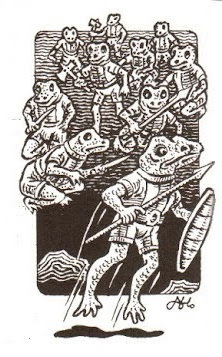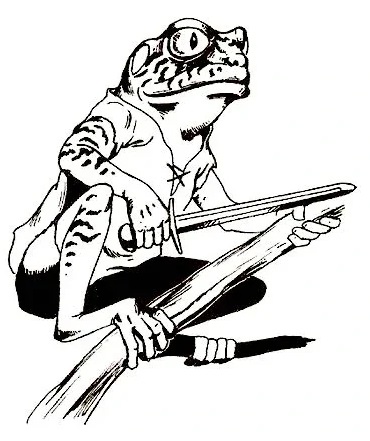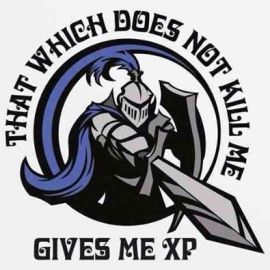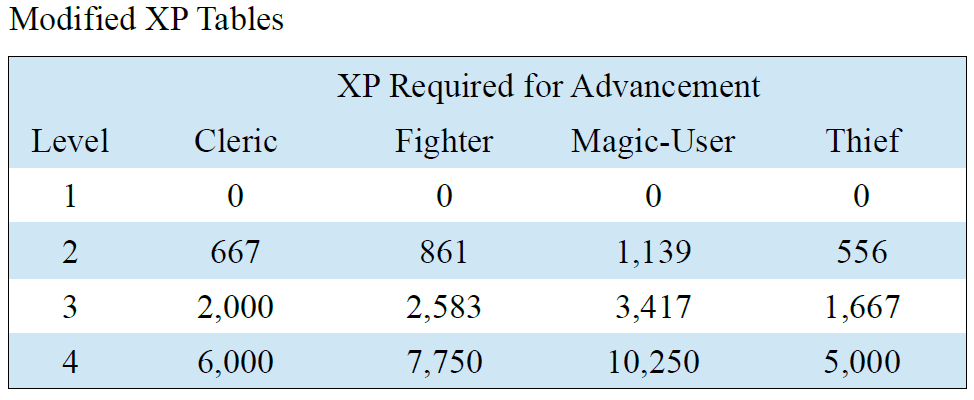Wastri & Self-Deception
We jump right into today’s Wastri-centric post!
Wastri is the demigod of amphibians, bigotry, and self-deception. This week’s posts have hit the first two. There’ve been monster frogs, “false human” hunters, and jumping priests. But what about self-deception? What is it, and why would anyone emulate a deity who encourages it? Let’s start with a definition taken from the on-line Stanford Encylopedia of Philosophy:
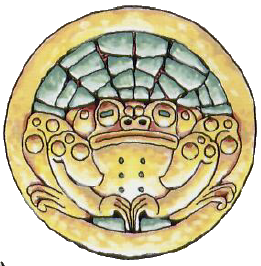
What is self-deception? Traditionally, self-deception has been modeled on interpersonal deception, where A intentionally gets B to believe some proposition p, all the while knowing or believing truly that ~p. Such deception is intentional and requires the deceiver to know or believe that ~p and the deceived to believe that p. One reason for thinking self-deception is analogous to interpersonal deception of this sort is that it helps us to distinguish self-deception from mere error, since the acquisition and maintenance of the false belief is intentional not accidental.
In other words, that aspiring Hopeful of Wastri knows that Wastri’s doctrine about human superiority is not true, but he deliberately chooses to believe and act as if the doctrine is true. In the Hopeful’s mind, we find two conflicting beliefs:
p: Humans are superior to all other humanoids.
~p: Humans are not superior to all other humanoids.
Resolving this contradictory set of beliefs is the function of bigotry. Bigotry helps the Hopeful generalize and specify in ways that explain the contradiction between his beliefs and reality. Euphemisms likely help this process. For example, consider what a simple change in terms accomplishes:
p: Humanity is superior to false humanity.
The first step in Wastri’s doctrine of self-deception must be to redefine terms. “Humans” is too specific. “Humanity” is abstract enough that the term becomes elastic, capable of stretching to reach whichever conclusions are most desired. Changing “all other humanoids” to “false humanity” not only creates a useful euphemism, but it also turns p into a statement that verges on self-evident. By definition, it seems, “false humanity” must be bad. “Humanity” is the opposite of “false humanity”; therefore, since “false humanity” is bad, “humanity” must be good. The Hopeful knows this is really just a semantic trick, but it creates a powerful motive for rationalizing his self-deception.
As the Hopeful progresses in his devotion to Wastri, he becomes more adept at rationalizing away the contradiction between p and ~p. Everything good about “false humanity” becomes a flaw obvious to the properly indoctrinated Hopeful. A dwarf’s ability to see in the dark? That’s not an example of a dwarf being superior to a human. Dwarves can see in the dark because they are creatures of darkness, hiding their wickedness from human eyes out of fear of just judgment. An elf’s centuries-long life span? This enables elves to both inflict their wickedness of the world for a long time and also encourages the vice of sloth. Why accomplish something today when one has decades to spare?
Et cetera.
The Hopeful’s process of rationalization also explains Wastri’s doctrines of self-improvement. The Hopeful sees his personal failures as sins related to not fully embodying humanity’s innate superiority. Thus, the Hopeful must study more, exercise more, work more, sacrifice more. Wastri’s followers who’ve advanced further along the path to personal perfection are there to help. Imagine a caste system of Wastrian self-improvement coaches, croaking out inspiring aphorisms to motivate the faithful and entice the curious.
Which bring us to Wastri’s alignment: lawful neutral (evil). Wastri’s worshipers are either lawful neutral or lawful evil. (See Dragon 71 from March 1983.) Now picture Wastri missionaries, all lawful neutral, establishing schools and gymnasiums, available for humans only, of course. As enrollment at the schools and gymansiums increases, so too does the revenue they generate, which Wastri’s faithful put back into the community, building better homes, improving infrastructure, providing employment, et cetera, but, as always, only for humans.
Years ago, in a 3E D&D campaign, I used Wastri, redefining his alignment to lawful neutral. In 3E’s rules, a cleric’s alignment could be “‘one step’ away from” his deity’s alignment (3E PH 29). So, a cleric of Wastri in that campaign could be lawful neutral, lawful evil, or lawful good. Based on this idea, I introduced into the campaign a lawful good paladin of Wastri, a missionary working hard to establish within the city a zone for humans to live and thrive along side other humans. The so-called “false humans” were not to be persecuted. The paladin encouraged “false humans” to live among their own kinds, to establish their own “racially pure” communities. Of course, the humans would occupy all important positions in the city’s government, and strict rules would be implemented to ensure that “false humans” did not infect the city with their inferior ways of living.
The players had to make a decision about what to do with the paladin. Despite his racist doctrines, he was a paladin. He was a lawful good man genuinely motivated to help the human community. He really believed that his program of racial segregation within a city ruled only by humans would ultimately benefit everyone — human and “false human” alike. The paladin was popular among the city’s humans as well as personally powerful with a small army of faithful at his command. The war waged by the forces of Hextor and his allies (the campaign’s major focus) was drawing closer to the city with each passing week. Compared to the slaughter looming on the horizon, could the PCs afford to not forge an alliance with Wastri’s paladin?
Unfortunately, we never answered that question. Due to player loss, the campaign sort of fizzled out. Among the PCs was another paladin, a human champion of Hieroneous. I had hoped that the clash of ideologies between the paladins would led to a situation in which Wastri’s doctrines of self-deception might have been undone. Maybe our current campaign can feature the return of this conflict? Only time will tell!
